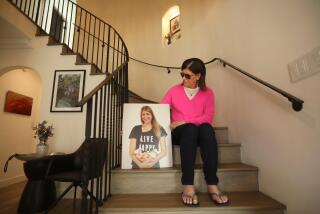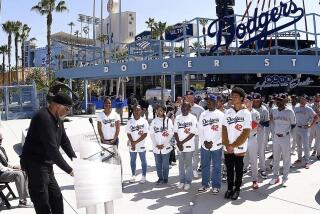After the Rainbow
“We’ve been prepared to die, but are we prepared to live?”
That was the question Michael Monroe asked in a Life & Style cover story two years ago, as the euphoria over the new AIDS medications--the protease inhibitor “AIDS cocktail”--was sweeping the HIV community.
As the drugs appeared to make them better, there was heady anticipation--as well as a daunting fear--for Michael, and other HIV-positive people who had given up homes, downsized, cashed in insurance policies, written wills and maxed out credit cards, only to be told that there was now hope. The road to Oz, it appeared, might still have wondrous miles ahead. The wicked witch might, miraculously, be held at bay.
The new drugs didn’t work. Michael’s memorial service was held Saturday. He was 54.
He had a miraculous year following his November 1996 Los Angeles Times profile. The drugs revived his nonexistent T-cells and vitality, and reduced his HIV-related problems.
“But by December he was back where he had been,” remembers Peter Hulitt, Michael’s roommate and fellow rebirther, a practitioner of an Eastern discipline involving breathing techniques that Michael had mastered in his spiritual awakening.
“He told me he could feel when the drugs stopped. He knew he was sliding, and dealing with that took inner work,” said Hulitt. “He knew where it was leading.” As Michael’s energy waned, his world grew smaller and smaller.
“At first it was, ‘Well, I only have 10 hours [of good health] a day, but I’ll live my life,’ ” friends said in quoting his philosophy. And with each contraction of life, Michael grieved but quickly adapted. “And when it became just one hour a day, he still took that hour and lived that hour.”
*
The memorial invitation was pure Michael: a color photo of him from many Thanksgivings ago, a model of handsome, robust masculinity in his black tank top and tight blue jeans, holding a freshly baked cherry pie, arms outstretched, campily posed with pursed lips--preening with an exaggerated housewife’s delight.
And the gathering in the hills of Silver Lake, hosted by Ken Carlsten and his partner Alan Lindgren, was a distillation of all the energies, across cultural and gender strata, and new-style family configurations that mark America at the millennium.
Ringing the gong, lighting incense and sharing memories were button-down gay friends in chino Dockers, a leather-lifestyle couple with matching back-pocket coded hankies, and a group of psychologists and rebirthers who had studied with Michael. There was also the contingent from his former life, co-workers from the Amtrak Star Coast train, where he had been the resident wit, sage and firebrand. There were his mother, brother and sister-in-law from Northern California. Also there was his home health-care nurse, who had come twice a week in the last year, after he had gone on intravenous feeding.
A fascinating intersection of one man’s life journey came together, disparate pieces that were united by a single man and his humanity. Michael had choreographed the memorial, joked his friends. The laughter, ribald humor, tell-it-like-it-is anecdotes, the sweet reminiscences were what Michael wanted.
“When I first told him about rebirthing, he told me my pantyhose were too tight,” laughed Dana DeLong, remembering the first time she described to Michael the cyclical breathing technique that frees trapped emotion. “But he came to find out more.”
“Michael was the biggest chunk of love I’ve ever met,” said Carlsten. “It was like he represented the life that I never had. When I was studying and being a good boy, Michael was out there, being alive, having fun.”
*
Like many with AIDS, or other life-threatening illnesses, Michael’s life was uplifted and empowered as he learned its value in direct proportion to its diminishing certainty. That shift from the workaday world of Amtrak waiter to the flowing of spiritual juices and becoming a therapist is the bittersweet lining of AIDS. Michael grew and flowered and found his own voice, and shared that voice with others.
“He personifies what it means to be big in the world,” said Stuart Altschuler, therapist and facilitator of the West Hollywood Hayride, the longest-running AIDS support group in America, which Michael occasionally attended.
The new medications have dramatically slowed and stopped the AIDS virus for many, but not all. Last year in Los Angeles there were still 2,463 newly diagnosed cases and 1,057 deaths from AIDS complications, according to the Los Angeles County Department of Health Services.
“We’re beginning to see the first people who took these drugs for a couple of years becoming ill, just like the old days,” said Scott Hitt, Michael’s physician and chairman of the President’s Advisory Council on HIV and AIDS. “There is concern over the next couple of years, if we don’t come up with a new drug. For people like Michael who are dying, this is just the tip of the iceberg.”
Two years ago in The Times, Michael expressed his desire to live and was the spokesman for the new hope and promise of living with AIDS. Michael Monroe is a reminder, and again the public voice for AIDS, that the epidemic is not over. Not for those with access to medication, not for those without.
“Michael taught me how to face life,” remembered Susan Barnes, his sister-in-law, as she tearfully addressed Michael’s friends, “and how to face death and do it with love, humor and dignity.”
After the ceremony, his mother, Barbara Doran, leaned over and whispered.
“These people aren’t the only people he taught. I was another one,” she said.
More to Read
Sign up for Essential California
The most important California stories and recommendations in your inbox every morning.
You may occasionally receive promotional content from the Los Angeles Times.










